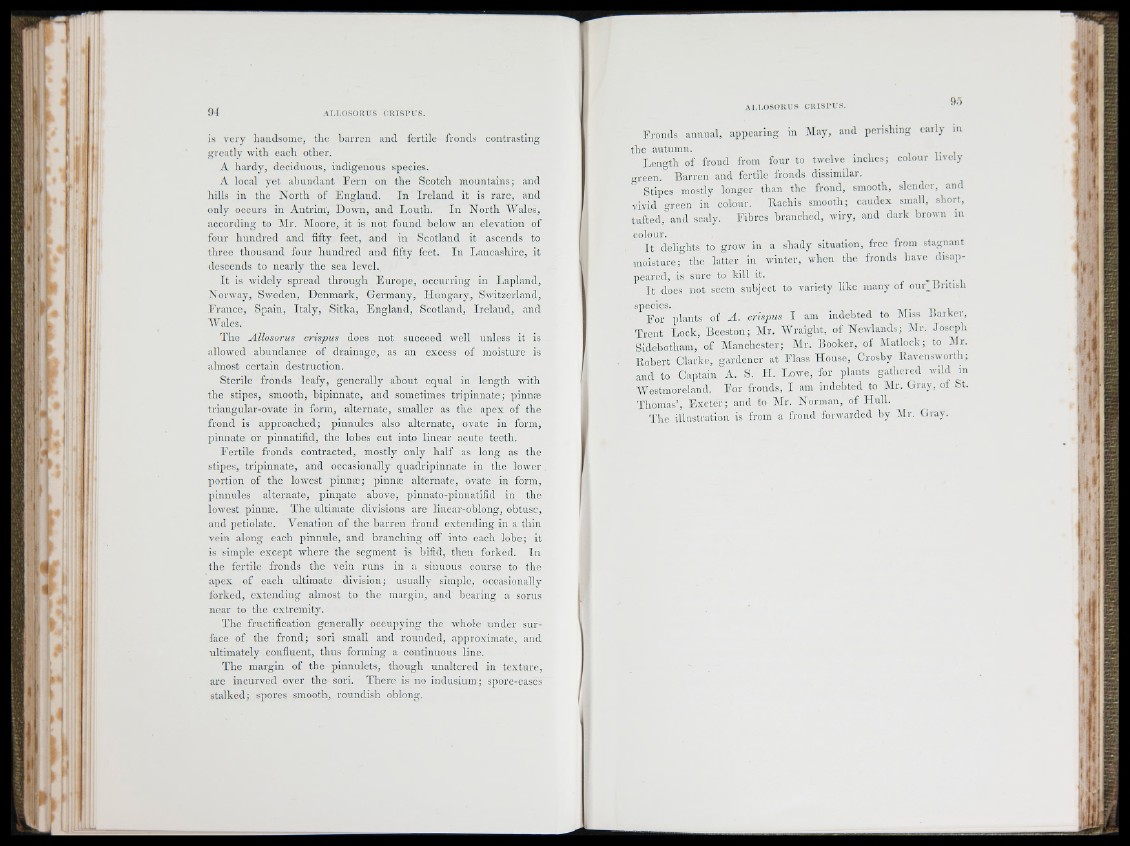
» !
» .
i
i
H
!)t .M. i .o s oKu s n i i s i - r s .
is l’ory luiuJsoinc, tlie b arren and fertile fronds contrasting
greatly with each other.
A h a rd y , deciduous, indigenous species.
A local yet abundant F e rn on th e Scotch mountains; and
hills in the N o rth of F n g lan d . I n Ire la n d it is ra re , and
only occurs in Antrim, Down, and Louth. In N o r th AVales,
according to JIi'. Alooro, it is not found below an elevation of
four h u n d red and fifty feet, and in Scotland it ascends to
th re e thousand four h u n d red and fifty feet. In I.ancashire, it
descends to nearly the sea level.
I t is widely spread th ro u g h E u ro p e , occurring in Lapland,
Norway, Sweden, Denm a rk , Germany, H u n g a ry , Switzerland,
France, Spain, Ita ly , Sitka, E n g la n d , Scotland, Ire la n d , and
Wales.
T'he Allosorus crispus docs n o t succeed well unless it is
allowed abundance of drainage, as an excess of moisture is
almost certain destruction.
Sterile fronds leafy, generally about equal in length with
the stipes, smooth, hipinnatc, and sometimes trip in n a te ; pinnæ
triangula r-ovate in form, alternate, smaller as the apex of the
frond is approached; pinnules also alternate, ovate in form,
p innate or pinuatifid, the lobes cut into linear acute teeth.
F e rtile fronds contracted, mostly only h a lf as long as the
stipes, trip in n a te , and occasionally quadripinnato in the lower
portion of the lowest pin næ; pinnæ alternate, ovate in form,
pinnules alternate, pinnate above, pinnato-pinnatlfid in the
lowest pinnæ. The ultimate divisions are linear-oblong, obtuse,
aud petiolate. Venation of the b a rre n frond e.xtending in a thin
vein along each pin n u le , and b ranching off into each lobe; it
is simple except where the segment is bifid, then forked. In
the ie rtile fronds the vein runs in a sinuous course to the
apex of each ultimate division; usually simjdc, occasionallv
ibrkcd, ex ten d in g almost to the margin, and bearing a sorus
n ear to the extremity.
T h e fructification generally occupying the whole u n d e r su rface
of the fro n d ; sori small and ro unded, apitroximatc, and
ultimately confluent, thus forming a continuous line.
T h e margin of th e p innulcts, th ough unalte red in tex tu re ,
arc in curved over the sori. T h e re is no indusium; spore-cascs
sta lked; spores smooth, roundish oblong.
A t . i . o s o i i i ' s e i i i s i ' f s
Fro n d s annual, appearing in May, and perishing early in
the autumn.
L ength of frond from four to twelve inches; colour lively
<n'ccn. Barren and fertile Ironds dissimilar.
” Stipes mostly longer th an the frond, smooth, slender, and
vivid green in colour. Rachis smooth; caudcx small, short,
tufted," and scaly. F ib re s branched, wiry, aud d ark brown in
colour.
I t delights to grow in a shady situation, free from stagnant
moisture; the latte r in winter, when the fronds have di.-ap-
pearcd, is sure to kill it.
I t does not seem subject to variety like many of o iu qL n tis li
species.
F o r plants of A . crisjms I am indeb ted to AIiss B a rk e r,
T re n t L ock, Bc cston; Air. W ra ig b t, of Newlands; Air. Joseph
Sidebotham, of Alanchester; Air. Booker, of Alatlock; to Air.
R o b e rt Clarke, gardener at Flass House, Crosby Ravenswortli;
and to Captain A. S. I I . Lowe, for plants gathered wild in
AVestmorcland. F o r fronds, I am indeb ted to Air. (rray , of St.
Thomas’, E x e te r; and to Air. Norman, of H u ll.
T h e illustration is from a frond forwarded by Air. Gray.
I
ii
•i